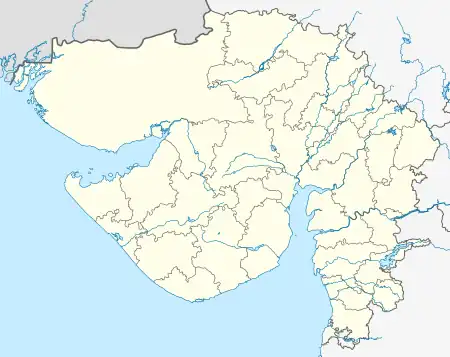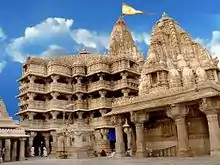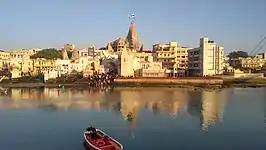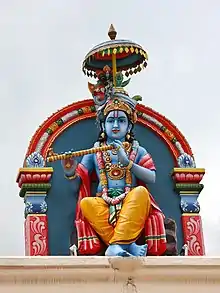Dwarkadhish Temple
The Dwarkadhish temple, also known as the Jagat Mandir and occasionally spelled Dwarakadheesh, is a Hindu temple dedicated to Krishna, who is worshiped here by the name Dwarkadhish (Dvārakādhisha), or 'King of Dwarka'. The temple is located at Dwarka city of Gujarat, India, which is one of the destinations of Char Dham, a Hindu pilgrimage circuit. The main shrine of the five-storied building, supported by 72 pillars, is known as Jagat Mandir or Nija Mandir. Archaeological findings suggest the original temple was built in 200 BCE at the earliest.[1][2][3] The temple was rebuilt and enlarged in the 15th–16th century.[4][5]
| Dwarkadheesh Temple | |
|---|---|
 The temple shikharas with the entrance in front | |
| Religion | |
| Affiliation | Hinduism |
| Deity | Krishna |
| Festivals | Krishna Janmashtami |
| Location | |
| Location | Dwarka |
| State | Gujarat |
| Country | India |
 Location in Gujarat | |
| Geographic coordinates | 22°14′16.39″N 68°58′3.22″E |
| Architecture | |
| Type | Temple |
| Style | Māru-Gurjara architecture |
| Completed | 15th–16th century (present architecture) |
| Website | |
| www | |
According to tradition, the original temple was believed to have been built by Krishna's grandson, Vajranabha, over the hari-griha (Krishna's residential place). The original structure was destroyed by Mahmud Begada in 1472, and subsequently rebuilt in the 15th–16th century, in the Māru-Gurjara style.
The temple became part of the Char Dham pilgrimage considered sacred by Hindus in India. Adi Shankara, the 8th century Hindu theologian and philosopher, visited the shrine. The other three being comprising Rameswaram, Badrinath and Puri. Even today a memorial within the temple is dedicated to his visit. Dwarakadheesh is the 98th Divya Desam of Vishnu on the subcontinent, glorified in the Divya Prabandha sacred texts.[6] The temple is at an elevation of 12.19 metres (40.0 ft) above mean sea-level. It faces west. The temple layout consists of a garbhagriha (Nijamandira or Harigraha) and an antarala (an antechamber).[7] However, the existing temple is dated to 16th century.
Legend

As per Hindu legend, Dwarka was built on a piece of land by Krishna that was reclaimed from the sea. According to the Mahabharata, the sage Durvasa once visited Krishna and his wife Rukmini. The sage wished that the pair took him to their palace, demanding that they pull his chariot like horses. The pair agreed and started to carry the sage, even as the latter struck Rukmini when she fell.[8] After some distance, according to local tradition, Rukmini got tired and she requested some water from Krishna. Krishna dug a hole with his powers that brought in river Ganga to the place. Durvasa was furious and cursed Rukmini to remain in the place. The temple where Rukmini's shrine is found, is believed to be the place where she stood.[9] In the epic, finding no fault with the divine couple, Durvasa blessed Krishna with invincibility everywhere except the soles of his feet, and declared that Rukmini would be the foremost of the deity's spouses and would be his eternal companion in the next world as well.[10]
History
The town of Dwarka in Gujarat has a history that dates back centuries, and mentioned in the Mahabharata epic as the Dwaraka Kingdom. Situated on the banks of river Gomti, the town is described in legend as the capital of Krishna. Evidence such as a stone block with script, the way the stones were dressed showing that dowels had been used, and an examination of anchors found on the site suggest that the harbour site dates only to historical times, with some of the underwater structure being late Medieval. Coastal erosion was probably the cause of the destruction of what was an ancient port.[11]
Hindus believe that the original temple was constructed by Vajranabha, the great grand son of Krishna, over the residential palace of Krishna. It was destroyed by Sultan Mahmud Begada in 1472.[12]
The current temple in Chaulukya style was constructed in 15-16th century.
Structure

The temple covers area of 27-metre by 21-metre with east–west length of 29-metre and north–south width of 23 metres. The temple is constructed of limestone and has intricate carvings.
It is a five storied edifice built over 72 pillars (sandstone temple with 60 pillars is also mentioned).[13][14][15] There are two important entrances to the temple, one is the main entry door which is called the Moksha Dvara (meaning "Door to Salvation") and the exit door which is known as the Svarga Dvara (meaning: "Gate to Heaven").[15] Outside this doorway are 56 steps that leads to the Gomati River.[16]
In the central sanctum is deitified the main deity Dwarkadhish, the Trivikrama form of Vishnu (see Chaturvimshatimurti). Dwarkadhish is depicted with four arms.[15] Balarama, elder brother of Krishna, is worshiiped in the chamber to the left of the main altar. The chamber to the right houses the images of Pradyumna and Aniruddha, son and grandson of Krishna respectively. In shrines surrounding the central shrine, the deities Radha, Jambavati, Satyabhama, and Lakshmi are placed.[15] Shrines of Madhav Raoji (another name for Krishna) and sage Durvasa is also present in the temple.[6] There are also two separate shrines dedicated to Radha Krishna and Devaki in front of the central shrine.
.jpg.webp)
The temple spire rises to a height of 78 metres (256 ft).[15] A flag, hoisted over the spire, shows the sun and moon, which is believed to indicate that Krishna would be there till the sun and moon exist on Earth.[17][15] The flag, triangular in shape, is of 50 feet (15 m) length. This flag is changed four times a day with a new one and Hindus pay a huge sum of money to hoist it by purchasing a new flag. The money received on this account is credited to the trust fund of the temple to meet the operation and maintenance expenses of the temple.[6]
Religious importance

Since this site is associated with the ancient city of Dvārakā and the Vedic era Krishna of Mahabharata, it is an important place of pilgrimage for Hindus. It is one of 3 main pilgrimage sites related to "Krishna" circuit, namely 48 kos parikrama of Kurukshetra in Haryana state, Braj Parikarma in Mathura of Uttar Pradesh state and Dwarka Parikrama (Dwarkadish Yatra) at Dwarkadhish Temple in Gujarat state.
Though the origins are not clearly known, the Advaita school of Hinduism established by Adi Shankara, who created Hindu monastic institutions across India, attributes the origin of Char Dham to the seer.[18] The four monasteries are located across the four corners of India and their attendant temples are Badrinath Temple at Badrinath in the North, Jagannath Temple at Puri in the East, Dwarakadhish Temple at Dwarka in the West and Ramanathaswamy Temple at Rameswaram in the South. Though ideologically the temples are divided between the sects of Hinduism, namely Shaivism and Vaishnavism, the Char Dham pilgrimage is an all Hindu affair.[19] The journey across the four cardinal points in India is considered sacred by Hindus who aspire to visit these temples once in their lifetime.[20] Traditionally the trip starts are the eastern end from Puri, proceeding in clockwise direction in a manner typically followed for circumambulation in Hindu temples.[20]
The temple is open from 6.00 am to 1.00 pm and 5.00 pm to 9.30 pm. The Krishna Janmashtami festival, or Gokulashtami, the birthday of Krishna was commissioned by Vallaba (1473-1531).[21]
According to a legend, Meera Bai, the famed Rajput princess who was also a poetess-saint and a staunch devotee of Krishna, merged with the deity at this temple.[14] It is one of the Sapta Puri, the seven holy cities of India.[15]
The temple is near the Dvaraka Pitha, one of the four pithas (religious centers) established by Adi Shankara (686-717) who pioneered unification of Hindu religious beliefs in the country.[14][6]
Awards
The Dwarkadhish Jagat Mandir was awarded the certificate of "World Amazing Place" on 22 March 2021 by the World Talent Organization, New Jersey, USA.[22][23]
Bibliography
- Bansal, Sunita Pant (1 January 2008). Hindu Pilgrimage. Pustak Mahal. ISBN 978-81-223-0997-3.
- Bandyopadhyay, Deepak (11 June 2014). Hinduism. Rupa Publications India Pvt. Ltd 2014. ISBN 978-81-291-3428-8.
- Desai, Anjali H. (2007). India Guide Gujarat. India Guide Publications. ISBN 978-0-9789517-0-2.
- Paramāra, Thomasa (1996). Temples of Gujarat Built During the Mughal Period. Thomas B. Parmar.
- UNESCO World Cultural Heritage Site status, report on Indian Express newspaper website
- Underwater remains near Dwarakadheesh temple, on website of National Institute of Oceanography
- Brockman, Norbert C. (2011). Encyclopedia of Sacred Places. California: ABC-CLIO, LLC. ISBN 978-1-59884-655-3.
- Gwynne, Paul (2009). World Religions in Practice: A Comparative Introduction. Oxford: Blackwell Publication. ISBN 978-1-4051-6702-4.
References
- S. R. Rao (1988). Marine Archaeology of Indian Ocean Countries. National Institute of Oceanography. pp. 18–25. ISBN 8190007408.
The Kharoshti inscription in the first floor of Sabhamandapa of Dwarkadhish Temple is assignable to 200 BC. [...] Excavation was done by the veteran archaeologist H.D. Sankalia some twenty years ago on the western side of the present Jagat-Man- dir at Modern Dwarka and he declared that the present Dwarka was not earlier than about 200 BC.
- L. P. Vidyarthi (1974). Journal of Social Research,Volume 17. Council of Social and Cultural Research. p. 60.
Inscription in brahmi found in the temple supports the fact of its construction during the Mauryan regime. Apart from this beginning, the pages of history of Dwarka and Dwarkadhish temple are full of accounts of its destruction and reconstruction in the last 2000 years.
- Alok Tripathi (2005). Remote Sensing And Archaeology. Sundeep Prakashan. p. 79. ISBN 8175741554.
In 1963 H.D. Sankalia carried out an archaeological excavation.. at Dwarkadheesh temple at Dwarka to solve the problem. Archaeological evidences found in this excavation were only 2000 years old
- 1988, P. N. Chopra, Encyclopaedia of India, Volume 1, p. 114.
- Rao, Shikaripur Ranganath (1999). The lost city of Dvārakā. Aditya Prakashan. ISBN 978-8186471487.
- Bandyopadhyay 2014, p. 71.
- Paramāra 1996, p. 87.
- Williams, George M. (27 March 2008). Handbook of Hindu Mythology. OUP USA. p. 125. ISBN 978-0-19-533261-2.
- Bhoothalingam, Mathuram (2016). S., Manjula (ed.). Temples of India Myths and Legends. New Delhi: Publications Division, Ministry of Information and Broadcasting, Government of India. pp. 87–91. ISBN 978-81-230-1661-0.
- Vyasa, Dwaipayana (24 August 2021). The Mahabharata of Vyasa: (Complete 18 Volumes). Enigma Edizioni. pp. 7206–7207.
- Gaur, A.S.; Sundaresh and Sila Tripati (2004). "An ancient harbour at Dwarka: Study based on the recent underwater explorations". Current Science. 86 (9).
- Goel, Sita Ram. (1994). The story of Islamic imperialism in India (2nd rev. ed.). New Delhi: Voice of India. ISBN 8185990239. OCLC 36040086.
- "Dwarka". Encyclopædia Britannica. Retrieved 19 April 2015.
- Desai 2007, p. 285.
- Bansal 2008, p. 20-23.
- Chakravarti 1994, p. 140
- "Dwarkadish Temple, Dwarkadish Temple Dwarka, Dwarkadish Temple in India". Indianmirror.com. Retrieved 4 March 2014.
- Mittal, Sushil (2004). The Hindu World. New York: Routledge. pp. 482–483. ISBN 0-203-64470-0.
- Brockman 2011, pp. 94-96
- Gwynne 2008, Section on Char Dham
- Harshananda, Swami (2012). Hindu Pilgrim centres (2nd ed.). Bangalore, India: Ramakrishna Math. p. 87. ISBN 978-81-7907-053-6.
- Gujarati, TV9 (22 March 2021). "Devbhumi Dwarka: દ્વારકાના જગતમંદિરને મળ્યું વર્લ્ડ અમેઝિંગ પેલેસનું સન્માન" [Devbhumi Dwarka: Dwarka's Jagatmandir honored with World Amazing Palace]. Tv9 Gujarati (in Gujarati). Retrieved 23 March 2021.
- "Shree Dwarkadhish Temple | World Talent Organization". worldtalentorg.com. 13 March 2021. Retrieved 23 March 2021.



